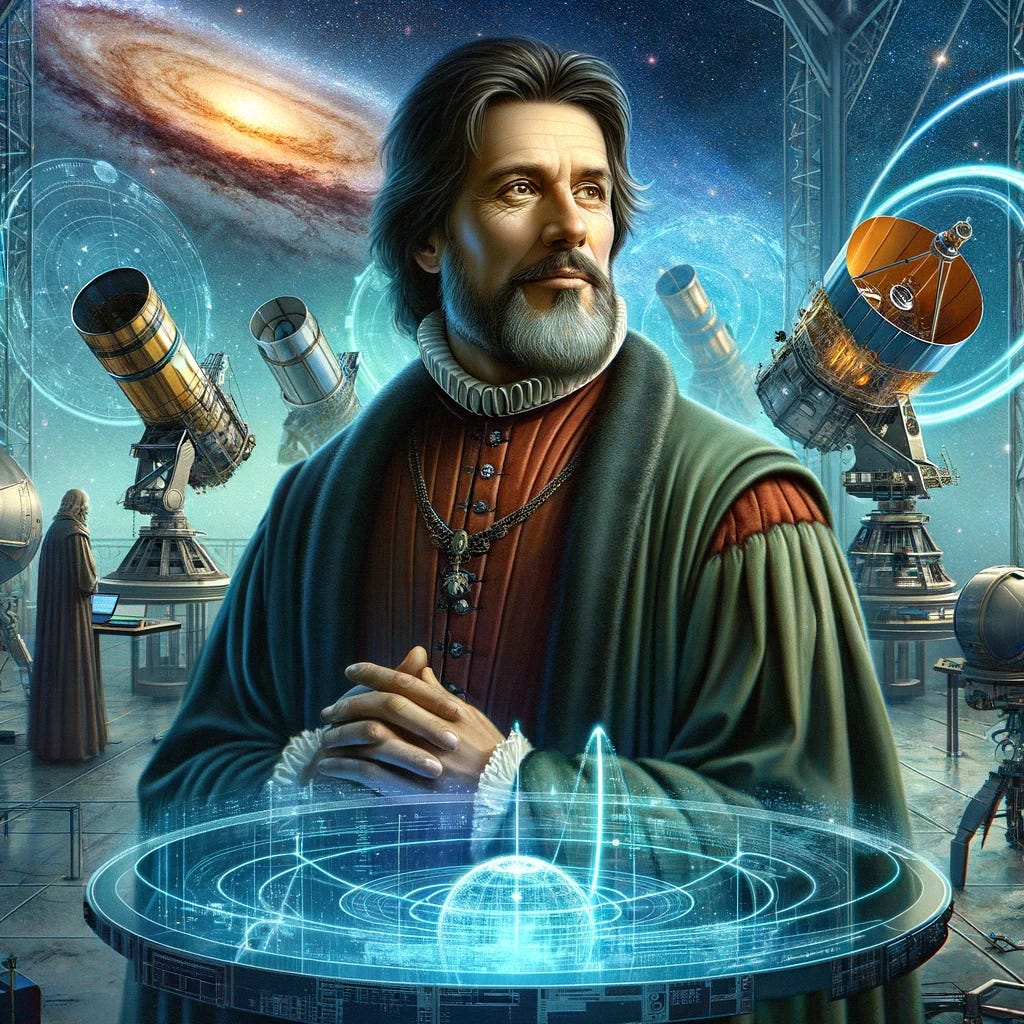Copernicus' Revolution: Unveiling the Universe with Modern Astronomy
Past Forward: Historical Icons in the Digital Frontier #15
Voice-over provided by Amazon Polly
Also, check out Eleven Labs, which we use for all our fiction.
Preface
Welcome to the fifteenth installment of our "Past Forward: Historical Icons in the Digital Frontier" series. In this series, we reimagine how historical figures would navigate and contribute to the scientific and technological advancements of the 21st century. Each article blends the timeless wisdom of these icons with the cutting-edge tools and knowledge of today, exploring their potential impact on contemporary challenges.
In this edition, we gaze at Nicolaus Copernicus, the brilliant astronomer who revolutionized our understanding of the cosmos with his heliocentric model. Born in the 15th century, Copernicus challenged the prevailing geocentric views and laid the groundwork for modern astronomy. His radical ideas transformed the scientific landscape and sparked a broader intellectual revolution.
Imagine Copernicus awakening in our modern world, surrounded by advanced telescopes, satellites, and computational tools. How would his insights evolve with access to instruments like the Hubble Space Telescope and the James Webb Space Telescope? How might he approach the mysteries of dark matter, dark energy, and the search for habitable exoplanets? In "Copernicus' Revolution: Unveiling the Universe with Modern Astronomy," we explore these fascinating questions, envisioning his contributions to contemporary astrophysics, cosmology, and interstellar exploration.
Join us as we bridge the gap between the past and the present, highlighting Copernicus' enduring legacy and its resonance in today's scientific endeavors. This journey honors his revolutionary spirit and inspires us to continue exploring the vast and wondrous universe with the same curiosity and determination that defined his life.
Conrad Hannon
Introduction: The Legacy of Copernicus
In the early 16th century, the Polish astronomer Nicolaus Copernicus challenged the established geocentric view of the cosmos with his revolutionary heliocentric model. Born in 1473, Copernicus spent decades observing the heavens and meticulously calculating the movements of celestial bodies. His groundbreaking work, "De revolutionibus orbium coelestium" (On the Revolutions of the Celestial Spheres), proposed that the Sun, not the Earth, was at the center of the universe. This paradigm shift laid the foundation for modern astronomy and catalyzed the scientific revolution.
Copernicus' heliocentric model overturned centuries of Ptolemaic astronomy, which held the Earth as the immovable center of the universe with planets and stars revolving around it. Copernicus fundamentally altered humanity's understanding of its place in the cosmos by placing the Sun at the center and asserting that the Earth and other planets orbit it. His contributions extended beyond astronomy, influencing physics, philosophy, and theology and paving the way for later scientists like Galileo, Kepler, and Newton.
Imagine Copernicus awakening in the 21st century, surrounded by advanced telescopes, satellites, and computational tools. Equipped with these modern instruments, he embarks on a journey to further unravel the mysteries of the universe. How would his profound insights and methods evolve in this era of technological marvels? This speculative narrative explores Copernicus' potential impact on contemporary astronomical challenges, blending his timeless wisdom with today's cutting-edge advancements.
Engaging with Modern Astronomy
Cosmic Observation:
Modern Tools: Picture Copernicus in a contemporary observatory, his eyes widening with awe as he peers through the Hubble Space Telescope and the James Webb Space Telescope. These powerful instruments reveal distant galaxies, vibrant nebulae, and far-off exoplanets with unprecedented clarity. Copernicus, once limited to rudimentary observational tools, now has access to the cosmos in ways he could never have imagined. With the Hubble, he delves into the intricacies of star formation and the life cycles of galaxies. The James Webb Telescope offers him a glimpse into the universe's earliest moments, providing data that could reshape our understanding of cosmic origins.
Insights on Dark Matter and Dark Energy: As Copernicus examines the data, he becomes intrigued by the elusive dark matter and dark energy, components that make up most of the universe yet remain largely mysterious. His methodical approach to problem-solving and deep understanding of celestial mechanics would likely drive him to formulate new hypotheses. Perhaps he would suggest innovative ways to detect dark matter through gravitational effects or propose experiments to better understand dark energy's influence on the universe's expansion. Copernicus' insights could bring fresh perspectives to these perplexing phenomena, potentially leading to breakthroughs in cosmology.
Exoplanet Discovery:
Techniques and Discoveries: Copernicus' curiosity about the celestial order would naturally extend to the search for exoplanets. Utilizing modern techniques such as transit photometry and radial velocity methods, he would eagerly contribute to the identification and study of planets orbiting distant stars. With the Kepler Space Telescope's data at his disposal, Copernicus could refine his understanding of planetary systems, mapping out the diverse configurations that challenge and expand the heliocentric model he pioneered.
Potential Insights: His rigorous analytical skills would lead him to scrutinize the conditions necessary for habitability. Copernicus might propose new criteria for evaluating exoplanetary atmospheres, focusing on signs of water, suitable temperatures, and protective magnetic fields. His work could inspire deeper investigations into the potential for life beyond Earth, emphasizing the importance of interdisciplinary research that combines astronomy, biology, and geology. Copernicus' perspective on the search for habitable planets would underscore the profound implications for understanding life's universality and the potential for discovering extraterrestrial civilizations.
Through these modern tools and techniques, Copernicus would extend his pioneering work and inspire new generations of astronomers to continue exploring the vast and wondrous universe.
Contributions to Contemporary Problems
Astrophysics and Cosmology:
Galactic Dynamics: Imagine Copernicus diving into the study of galaxy formation, structure, and evolution with the zeal of a pioneering astronomer. His background in celestial mechanics would be invaluable in analyzing the gravitational forces that shape galaxies. Using data from modern observatories, he could model the interactions between dark matter and baryonic matter, offering insights into spiral arm formation, galactic collisions, and the mysterious processes driving galactic evolution. Copernicus might develop new theories on the life cycles of galaxies, from their formation in the early universe to their eventual merging and transformation.
Cosmic Microwave Background: The cosmic microwave background (CMB) radiation, the afterglow of the Big Bang, would fascinate Copernicus. He could refine our understanding of the universe's infancy by analyzing the CMB's uniformity and slight variations. His meticulous approach would likely lead him to explore the implications of these early fluctuations for the large-scale structure of the cosmos. Copernicus might propose novel methods to extract more information from the CMB, potentially unlocking new secrets about the universe's origin, composition, and the forces that have shaped it over billions of years.
Interstellar Exploration:
Mission Planning: With his expertise in orbital mechanics, Copernicus would excel in planning interstellar missions. He would likely utilize principles of gravitational assists and optimal trajectory calculations to maximize energy efficiency and minimize travel time. His plans for missions to nearby star systems, such as Proxima Centauri, would involve innovative propulsion techniques, perhaps leveraging advancements in ion drives or light sails. Copernicus’ strategic approach would ensure that interstellar probes are designed to gather the maximum amount of scientific data while navigating the vast distances of space.
SETI and Beyond: The Search for Extraterrestrial Intelligence (SETI) would capture Copernicus’ imagination. He would approach the quest for intelligent life with a combination of rigorous scientific methodology and philosophical curiosity. Copernicus might suggest refining the search criteria, focusing on signals that indicate advanced technological civilizations. He could propose new algorithms for analyzing the vast data collected by radio telescopes and other observatories. His thoughts on potential contact with other civilizations would be grounded in the recognition of the profound implications for humanity’s understanding of its place in the cosmos. Copernicus might also emphasize the importance of preparing for the ethical and practical challenges of such a discovery.
Through his contributions to astrophysics, cosmology, and interstellar exploration, Copernicus would significantly advance our understanding of the universe and our place within it. His blend of ancient wisdom and modern scientific inquiry would provide a unique and valuable perspective on some of humanity's most profound questions.
Philosophical and Ethical Insights
Scientific Philosophy:
Epistemology: Copernicus' approach to knowledge and discovery was revolutionary for his time, characterized by a relentless questioning of established paradigms. His heliocentric model challenged the deeply entrenched geocentric views that had dominated for centuries. In the modern context, Copernicus would likely advocate for a similar epistemological stance, encouraging scientists to continually question and test prevailing theories. His method of basing conclusions on careful observation and mathematical rigor would serve as a reminder that scientific progress often requires challenging the status quo and embracing new ideas that better explain the natural world.
Interdisciplinary Thinking: One of Copernicus' strengths was his ability to integrate mathematics, astronomy, and philosophy into a cohesive framework for understanding the universe. This interdisciplinary approach is even more relevant today, as complex scientific problems often require insights from multiple fields. Modern research, with its emphasis on collaboration across disciplines, would resonate with Copernicus’ methodologies. He would likely champion the integration of diverse scientific perspectives to foster innovation and comprehensive understanding. Copernicus' legacy would continue to influence contemporary research methodologies and academic discourse by combining mathematical precision, astronomical observation, and philosophical inquiry.
Ethics in Astronomy:
Exploration vs. Exploitation: Copernicus' respect for the natural order would inform his views on the ethical dimensions of space exploration and resource utilization. He would likely advocate for a balance between exploration and conservation, emphasizing the need to avoid exploiting celestial bodies in ways that could cause harm. Drawing parallels to his careful and respectful study of the heavens, Copernicus might propose ethical guidelines for mining asteroids, establishing lunar bases, or colonizing Mars. His perspective would underscore the importance of preserving the integrity of extraterrestrial environments while pursuing scientific and economic benefits.
Global Collaboration: Inspired by Copernicus' inclusive approach to knowledge, the importance of international cooperation in astronomical research cannot be overstated. Copernicus worked within a network of European scholars, sharing ideas and discoveries. In today’s context, he would likely champion global collaboration to address space exploration's immense challenges and opportunities. This would include sharing data from space missions, coordinating efforts in planetary defense, and developing international policies for space governance. Copernicus' inclusive and collaborative spirit would be a guiding principle in fostering a cooperative and peaceful exploration of space, ensuring that the benefits of astronomical research are shared universally.
By applying his philosophical and ethical insights to modern scientific endeavors, Copernicus would advance our understanding of the universe and guide the ethical and collaborative principles that ensure responsible and inclusive exploration. His approach to knowledge, interdisciplinary thinking, and ethical considerations would continue to inspire and shape the future of astronomy and space science.
Educational and Inspirational Impact
STEM Education:
Hands-On Learning: Copernicus' meticulous observational methods and mathematical calculations can greatly inspire hands-on learning in modern education. His approach encourages students to engage directly with the material world, making precise observations and conducting experiments to test their hypotheses. For example, students could use simple telescopes to observe planetary movements, recreate his calculations using modern software, or build models to understand celestial mechanics. By engaging in these practical activities, learners can gain a deeper appreciation for the scientific process and the historical advancements that have shaped our current understanding of the universe.
Innovative Thinking: Copernicus’ legacy of challenging established ideas promotes creative problem-solving and critical thinking in STEM fields. His bold hypothesis that the Earth orbits the Sun was a radical departure from accepted views and required innovative thinking to defend. Educators can use Copernicus' story to encourage students to think outside the box and question conventional wisdom. By fostering an environment where novel ideas are welcomed and rigorously tested, schools can cultivate a new generation of scientists and engineers unafraid to explore uncharted territories and propose groundbreaking theories.
Inspiring Future Generations:
Role Model: Nicolaus Copernicus is an enduring role model for aspiring astronomers and scientists. His determination, intellectual curiosity, and commitment to uncovering the truth despite significant opposition exemplify the qualities of a great scientist. Presenting Copernicus' journey—from his early education and diverse interests in medicine, law, and astronomy to his revolutionary publication—can inspire students to pursue their passions with similar fervor. Emphasizing his perseverance and innovative spirit can motivate young learners to overcome challenges and contribute meaningfully to their chosen fields.
Educational Programs: Incorporating Copernicus’ life and work into educational programs can spark curiosity and a love for science. Schools and universities might develop curricula that explore his contributions in a multidisciplinary context, integrating astronomy, history, and mathematics. Science museums and planetariums could create interactive exhibits or virtual reality experiences that allow visitors to "walk in Copernicus' footsteps" and explore the solar system through his eyes. Additionally, educational programs could include workshops and seminars where students engage with Copernican principles through hands-on activities, debates, and collaborative projects.
By embedding Copernicus’ methodologies and achievements into the fabric of STEM education, educators can cultivate a deeper understanding and appreciation of scientific inquiry. His legacy encourages students to engage actively with scientific questions, think creatively, and pursue their discoveries passionately and persistently. This approach honors Copernicus' contributions and prepares students to become innovative thinkers and problem-solvers of the future.
Conclusion: Copernicus' Modern Resonance
Synthesis of Old and New: In our speculative journey, Nicolaus Copernicus awakens in the 21st century, his revolutionary spirit invigorated by modern technology. He seamlessly blends his ancient wisdom with contemporary advancements, using telescopes like Hubble and James Webb to explore the cosmos with unprecedented clarity. His foundational principles of celestial mechanics find new applications in the study of galactic dynamics and interstellar mission planning. With modern tools at his disposal, Copernicus extends his heliocentric model into the realms of dark matter, dark energy, and the search for habitable exoplanets. His rigorous methods and philosophical insights offer fresh perspectives on some of the most perplexing questions in modern astronomy, demonstrating that the core tenets of scientific inquiry remain timeless.
Continuing Relevance: Copernicus' enduring legacy exemplifies the timeless nature of curiosity and the relentless pursuit of knowledge. His willingness to challenge established paradigms and embrace innovative thinking continues to inspire scientists and thinkers today. Copernicus’ story is a testament to the power of questioning the status quo and pushing the boundaries of human understanding. In blending historical insight with cutting-edge technology, his hypothetical journey highlights the continuous thread of intellectual exploration that spans centuries. His contributions remind us that the quest for knowledge is an ongoing adventure that transcends time and continues to shape our understanding of the universe.
By reflecting on Copernicus’ modern resonance, we celebrate the enduring impact of his legacy and its relevance to contemporary science. His innovative spirit and methodological rigor provide a guiding light for future generations, encouraging a harmonious blend of curiosity, critical thinking, and technological prowess in the ever-evolving journey of discovery.
Thank you for your time today. Until next time, stay gruntled.
Do you like what you read but aren’t yet ready or able to get a paid subscription? Then consider a one-time tip at:
https://www.venmo.com/u/TheCogitatingCeviche
Ko-fi.com/thecogitatingceviche







